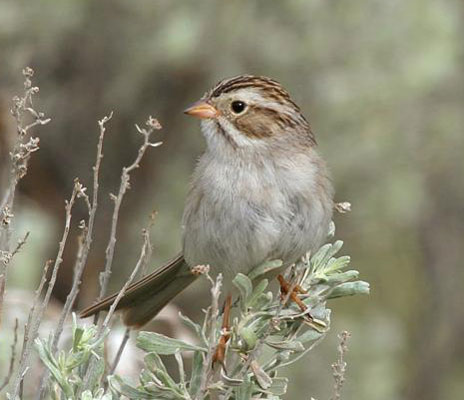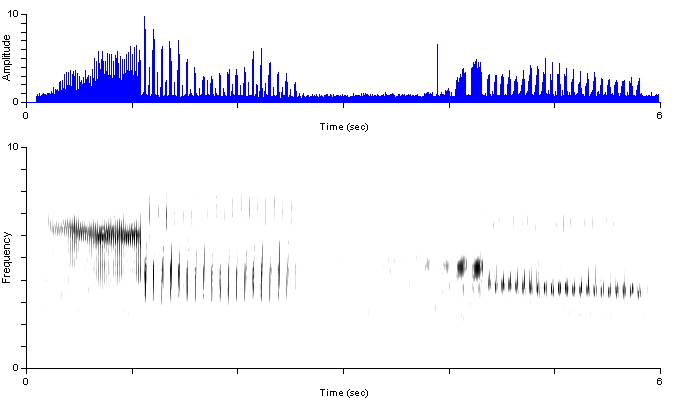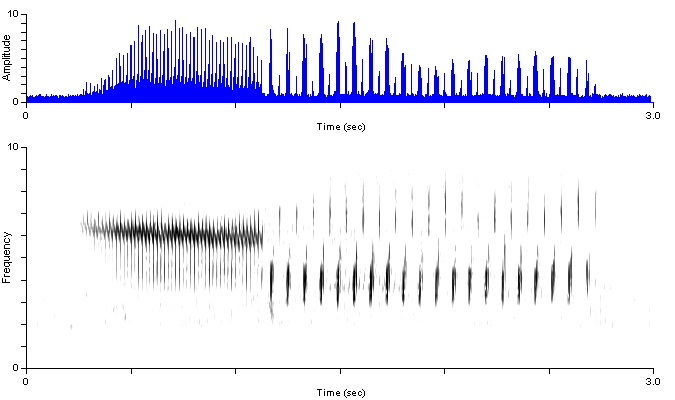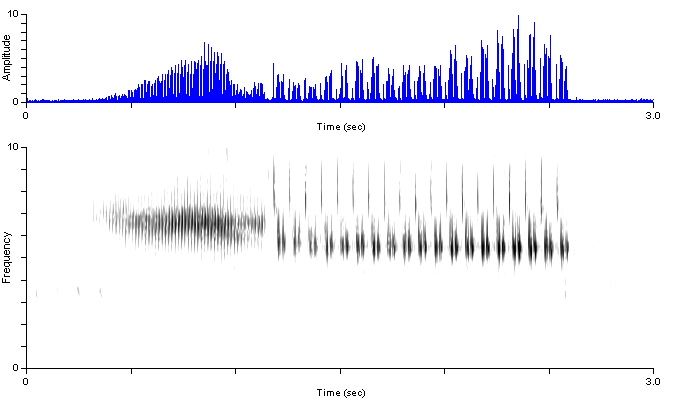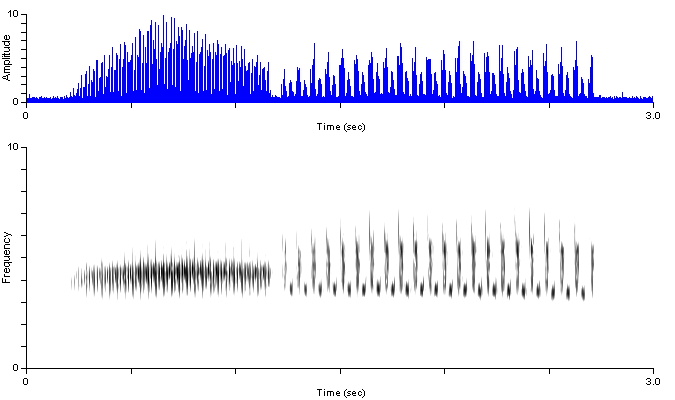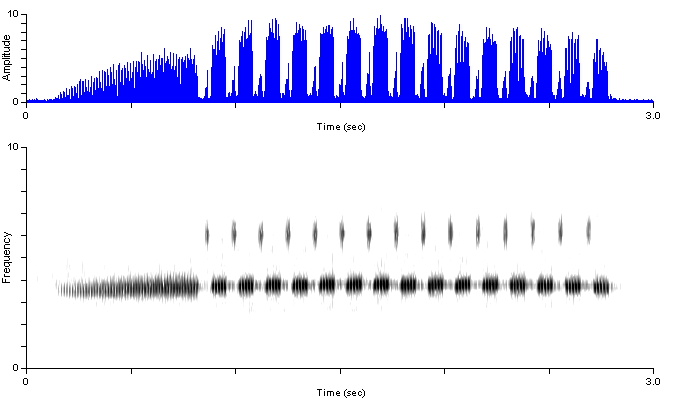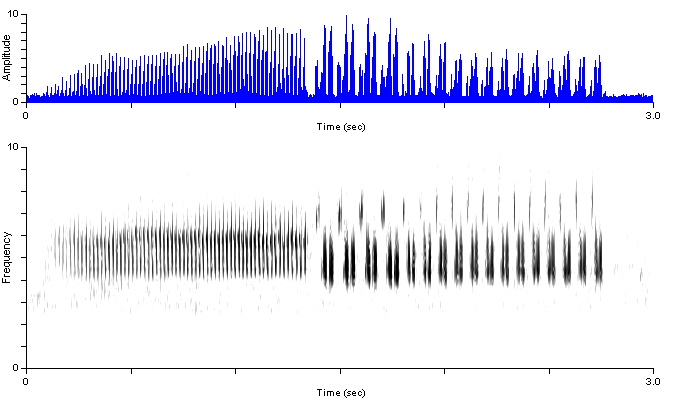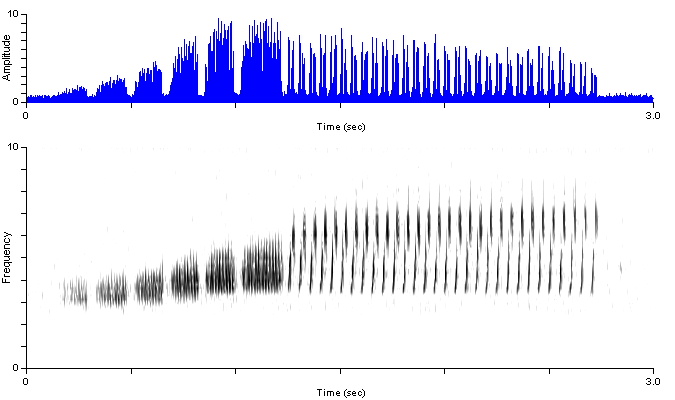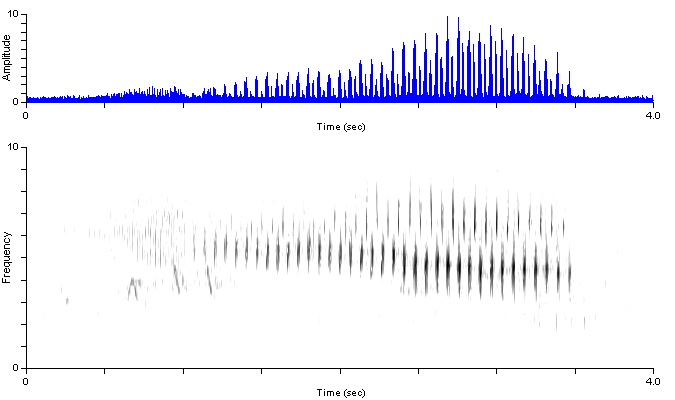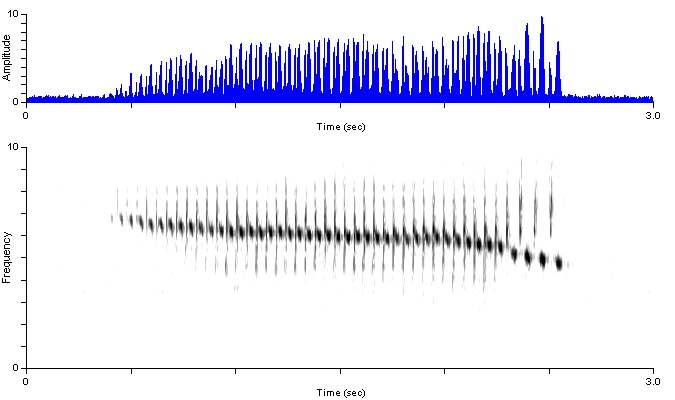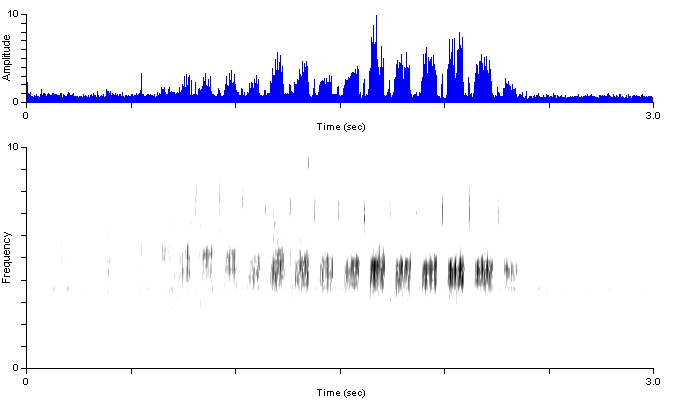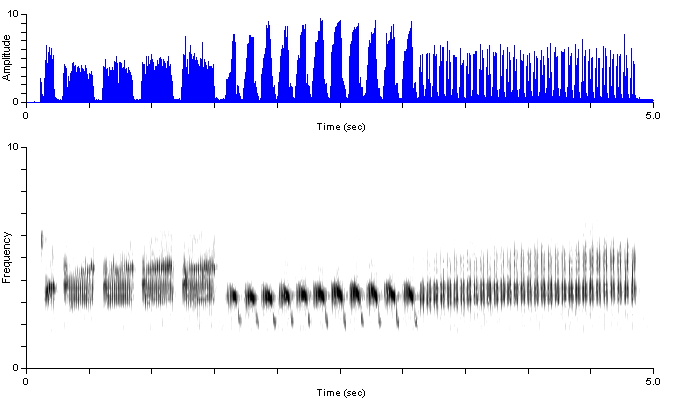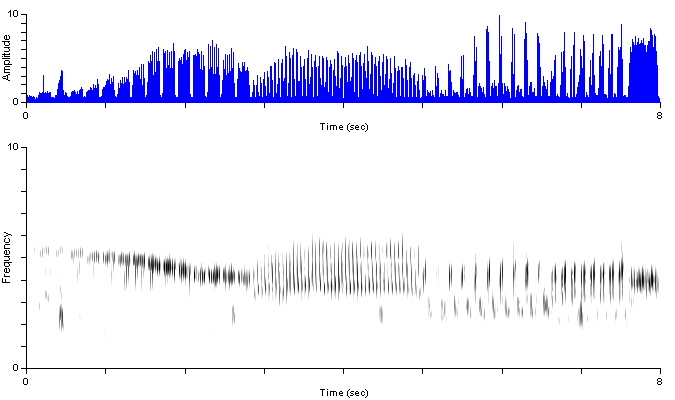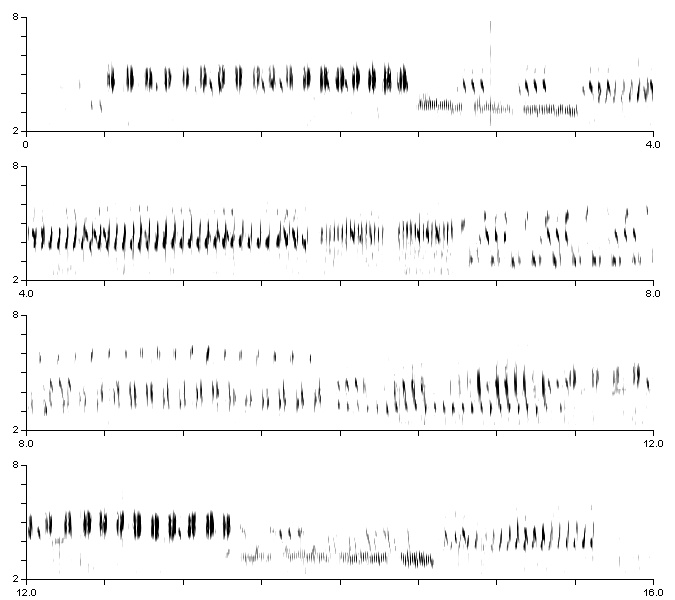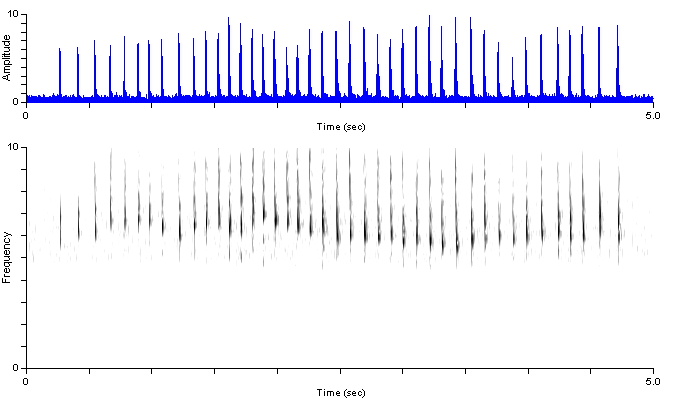|
But do not despair. The Brewer's Sparrow is a vocal show-off, the unmatched master of trills. The clicking quality of these sounds seems to fit the heat waves rising from the sagebrush at midday, but it is usually "Short Songs" that you hear then. The pinnacle of this bird's virtuosity, the "Long Song", is more likely to be heard at dawn and dusk. Why? As in many other species (best-studied in warblers), the male Brewer's Sparrow sings one way when paired and another way when looking for a mate. According to Brett Walker of the University of Montana, both paired and unpaired males sing long songs in the dawn chorus and in territorial interactions. They use a variety of song types, constructed by stringing together different trill-types from a large repertoire. Paired males sing little after dawn, but unpaired males keep after it all day, intermittently. These unpaired males typically use only a single type of short song. If paired males do sing after dawn, they are more likely to use long song, except when they are trying to attract a second mate. If they do this they use short song, out of earshot of their primary mate's territory. This latter behavior certainly suggests that short song is more important for attracting females. The role of song in attracting EPCs in Brewer's Sparrow is not known. What this boils down to is that you can get a pretty accurate impression of the number of males present by listening to the dawn chorus, but after that you will be hearing mostly "losers." These are birds that have lost their mates and those that have never attracted one. On the other hand, the occasional short-singer may be a would-be bigamist. I've recorded Brewer's Sparrows off and on for the past 25 years, but I have few recordings of the long song. Even though it makes a lasting impression, it's difficult to record, because the wind is often blowing in the treeless shrub-steppe where these birds nest. In fact, that wind is the reason for this over-long succession of trills. Birds that live in open, and therefore windy, habitat tend to trill a lot, because repetition is a good way to get a message across when chunks of it are likely to be lost in transmission. If a breeze blows up while you are listening to a Brewer's Sparrow, you will notice that it can blow away parts of the song. A trill is actually a series of identical clicks. If you hear the beginning and end of the trill, can make out the acoustic quality of some of the clicks, and hear enough to estimate the repetition rate of the clicks, you don't need to hear all of them. Your brain can fill in the blanks caused by the wind. Perhaps for this reason, click trains are very common sounds in the animal world. Usually it is very simple features of these trains that communicate the information, things such as duration, amplitude, and rate. One way of telegraphing the beginning and end of a specific trill is to switch to a very different trill-type. Brewer's Sparrows seem to do this (see sound 12 below). The repetition rates and the apparent pitches of adjacent trill types seem to differ more than they would if the trills were ordered randomly. This is quite evident in Short Song, which usually is a fast trill followed by a slow trill, the whole lasting less than 3 seconds. Long song can last 18-20 seconds, and may have half a dozen or more different trills, with some types repeated later in the song. The extreme redundancy of these songs suggests that they are either very important, or very likely to be degraded by noise, or both. Below, I present Short Songs (Sounds 1-11) first so you can see the fine structure of the trills. Long Songs (Sounds 12-13) use the same trills, just more of them and more types. Sound 14 is a string of call notes repeated at regular intervals.
The Brewer's Sparrow is a bird of Big Sagebrush (Artemisia tridentata and
other shrubs that dominate the arid shrub-steppe of the Great Basin.
It is currently on a number of watch lists, because shrub-steppe is dwindling
before the march of economic development.
See
Greater Sage-Grouse for more information
on this situation.
A population currently recognized as a subspecies of the Brewer's Sparrow,
Spizella breweri taverni, the "Timberline Sparrow," breeds disjunctly
in northwestern Canada and adjacent Alaska in stunted conifers at treeline.
Some authorities consider it a separate species, and others believe that it
occurs in our region (but see BOGR).
Any Brewer's Sparrow found at timberline should be recorded
if it sings, as the songs of the shrub-steppe and timberline forms are said to
be different.
|
SOUNDS
|
1. SONG : Short Typical "Short Songs" by two birds. Both consist of a fast trill or buzz followed by a slower trill. The book on this species is that each bird will repeat the same song type again and again, and that is just what they did. Singing "Short Song" at mid-day, as they were, they were likely unpaired and seeking mates. Habitat: Sagebrush; Location: Near Silvies, Harney County, OR; Date 06-19-2004. |
|
2. SONG : Short "Short Song," another example from the first bird in the figure above. Habitat: Sagebrush; Location: Beside US 395, near Silvies, Harney County, OR; Date 06-19-2004. |
|
3. SONG : Short Typical "Short Song," with two trills. The second trill, though similar in form to other second trills, is higher in pitch than many of these. Note also the abrupt frequency shifts in the second, slower, trill. The bird is probably using its two "voices" to make the high and low clicks independently, i.e., it is shifting sound production from one side of the syrinx to the other in 15/1000 of a second. Habitat: Sagebrush; Location: Bowen Valley, Baker County, OR; Date 06-21-2003. |
|
4. SONG : Short Typical "Short Song." Notice that each unit of the second trill has three frequency components. Habitat: Sagebrush; Location: southwest of Doris, near Meiss Lake, Siskiyou County, CA; Date 05-15-2005. |
|
5. SONG : Short Notice the rather slow rate of the second trill in this otherwise typical "Short Song." |
|
6. SONG : Short Typical "Short Song." Habitat: Sagebrush; Location: Hart Mountain National Antelope Range, Lake County, OR; Date 06-11-2002. |
|
7. SONG : Short Photographer Stever Berliner captured this nice sample of a somewhat unusual "Short Song" with a hand-held MP3-recorder. Note that the first trill rises in pitch, and is broken into countable units, like the second song of sample 1. Habitat: Sagebrush; Location: Cabin Lake, Lake County, OR; Date 07-08-2005. |
|
8. SONG : Short This "Short Song" does have two trills, but the first is faint, and the contrast between the two trills is slight. These characteristics gave me pause when I heard this bird among Chipping Sparrows in a patch of high-elevation sagebrush surrounded by pines, but I finally saw it and the chippies and confirmed the identifications. Notice also the longer duration of this song. The cut is 4 seconds long, not 3. Habitat: Sagebrush; Location: Forest Road 2820, east of US 395, Harney County, OR; Date 06-19-2004. |
|
9. SONG : Short This "Short Song" has only one trill, but it is still the typical duration, close to 3 seconds. |
|
10. SONG : Short This is a poor recording because of high wind and distance to the bird. I include it here because this is a rather unusual "Short Song." When I heard it I was not at all sure what it was, so I followed the sound through the sagebrush until I finally got a glimpse of a Brewer's Sparrow. I heard it on the next stop of this BBS route, too, so it must be a local dialect. Habitat: Sagebrush; Location: Trout Creek BBS, North of Denio, Harney County, OR; Date 05-29-2005. |
|
11. SONG : Short A "Short Song" with three trills, which is quite unusual. |
|
12. SONG : Long This is a relatively short "Long Song," only 5 trills and 8 seconds long. It was delivered with the sun well up, so odds are this was a paired bird. Click the link above the spectrogram to view and hear a video clip. Notice that the bird turns his head while singing, and compare the orientation of his head with the amplitude display above the spectrogram. Also, notice that the bird's bill opens and closes with each click of the slow trills. Play the clip again and you may notice the bird's bill opening and closing in time to even the faster trills. The amplitude of these bill movements seems to vary inversely with the trill rate, i.e., the slower the trill, the wider the bill opens. A Red-winged Blackbird delivers a note 4 times during the cut; you can see it on the spectrogram at 2-3 kHz. Habitat: Sagebrush; Location: Hart Mountain National Antelope Range, Lake County, OR; Date 06-11-2002. |
|
13. SONG : Long This is a very long "Long Song." Notice first that the bird is competing for our attention with a cricket. That gives away that this song was delivered at dusk. In fact, it was very nearly dark when I recorded this song; Common Poor-wills were already singing. Each chirp of the cricket is 3 or 4 nearly vertical traces at 4-5 kHz. They are most noticeable at the 3 second mark, where the bird has shifted to a lower frequency, but they are actually there throughout the cut, usually overlapping with the sparrow's trills. Also notice that the song begins and ends with the same three trill types, in the same order. Habitat: Sagebrush; Location: Hart Mountain National Antelope Range, Lake County, OR; Date 06-13-2002. |
|
14. NOTE : Train This bird has combined short contact notes into a call. |
All recordings presented here are the property of the recordists and are used with permission. The name of the recordist appears below each spectrogram.
Spectrograms, text, design, and source code are the property of AppliedBioacoustics. © 2004 AppliedBioacoustics.com
